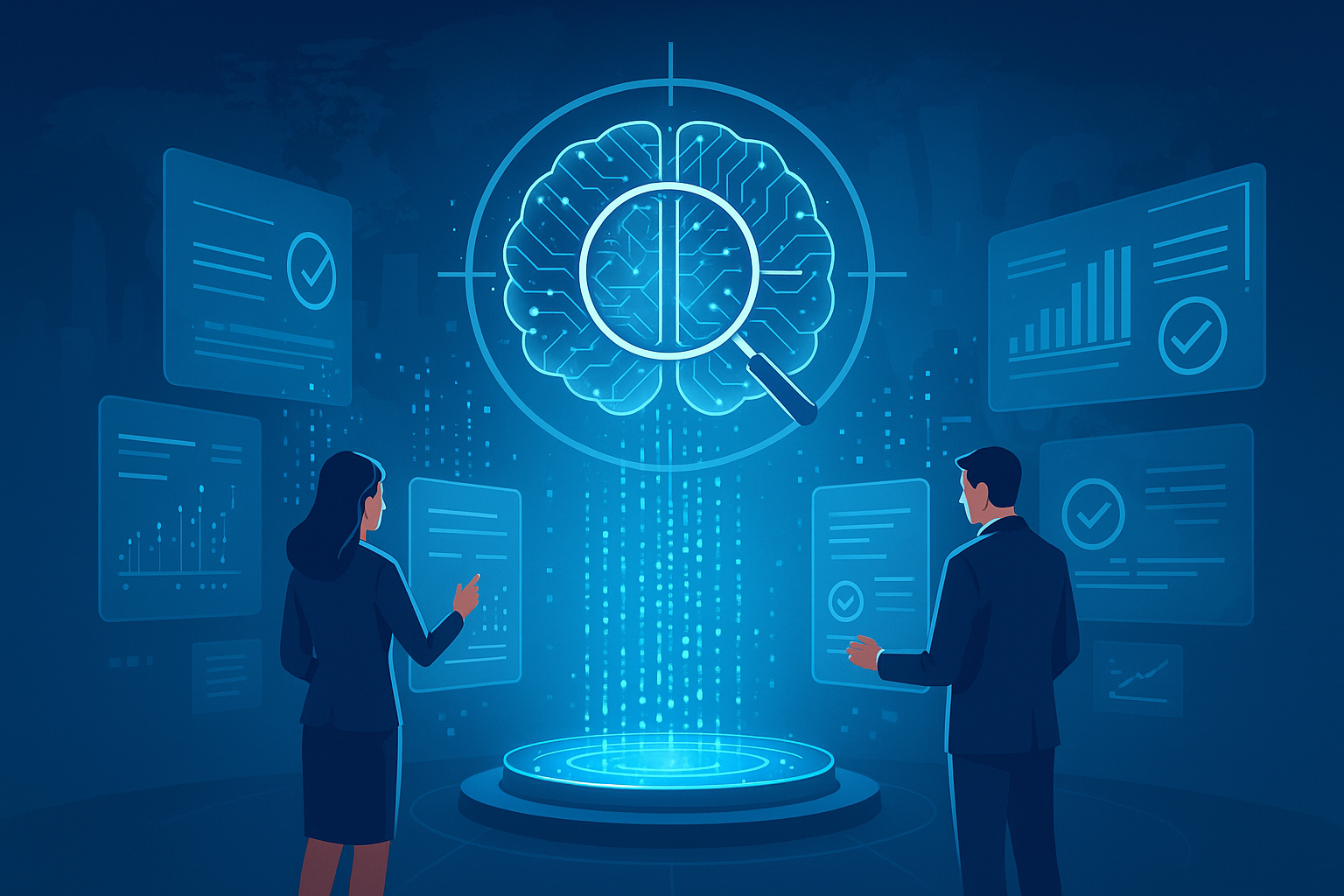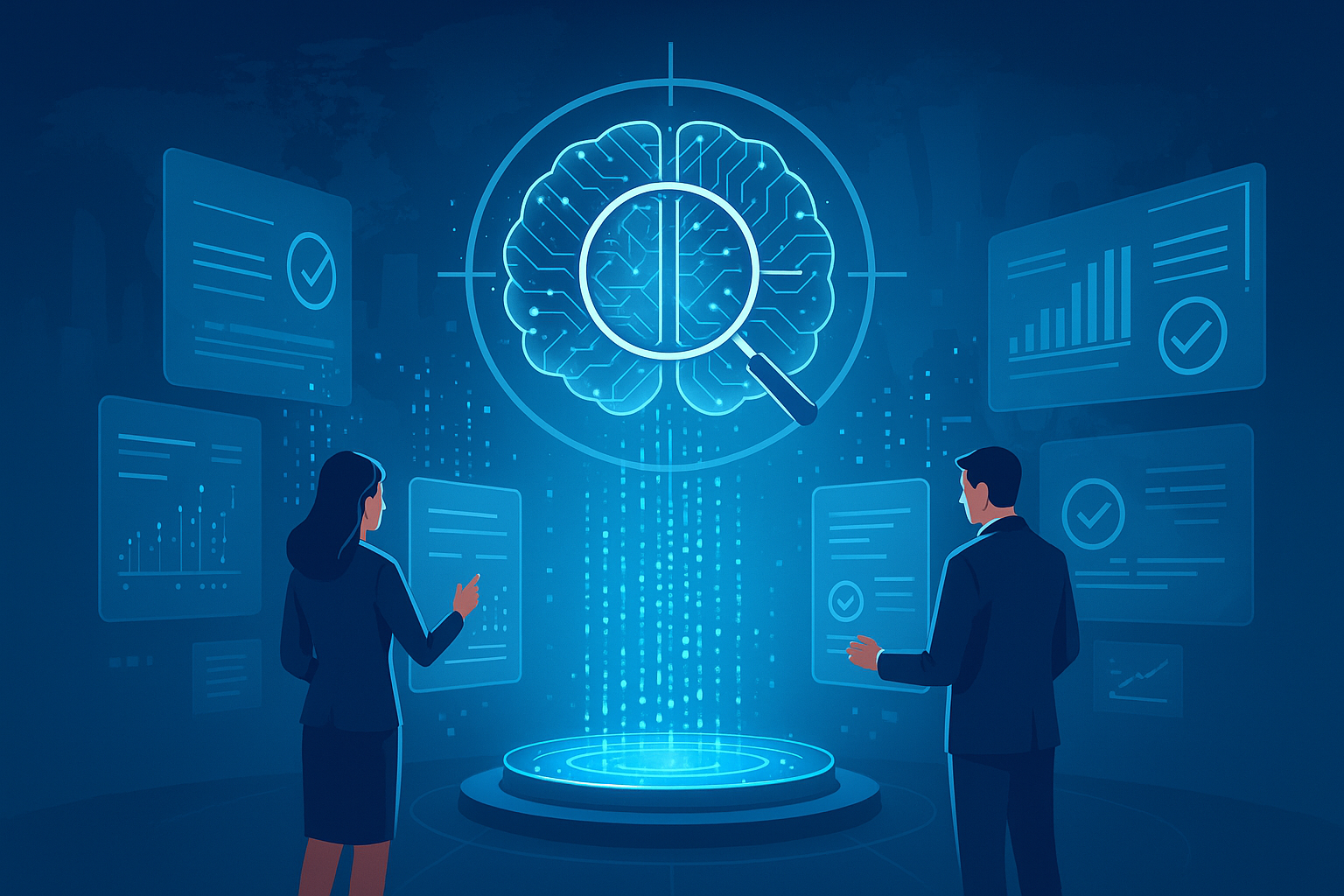The Transformative Role of Generative AI in Financial Crime Compliance
.svg)
When we look at the financial crime landscape today, it’s clear that we’re on the brink of a significant evolution. The traditional methods of combating money laundering and fraud, which have relied heavily on rule-based systems and static models, are rapidly being eclipsed by the transformative potential of artificial intelligence (AI) and machine learning (ML). Over the last two decades, these technologies have fundamentally changed how we identify and respond to illicit activities. But as we look into the next few years, a new tech transformation is set to reshape the field: generative AI.
This isn't just another technological upgrade—it’s a paradigm shift. Generative AI is poised to redefine the rules of the game, offering unprecedented capabilities that go beyond the detection and prevention tools we’ve relied on so far. While ML has already improved our ability to spot suspicious patterns, generative AI promises to tackle more sophisticated threats, adapt faster to evolving tactics, and bring a new level of intelligence to financial crime compliance.
But with this promise comes a critical question: How exactly will generative AI or specifically, Large Language Models (LLM) transform financial crime compliance? The answer lies not just in its advanced capabilities but in its potential to alter the way we approach detection and prevention fundamentally. As we prepare for this next wave of innovation, it’s essential to understand the opportunities—and the challenges—that come with it.

When it comes to leveraging LLM in financial crime compliance, the possibilities are profound. Let’s break down some of the key areas where this technology can make a real impact:
- Data Generation and Augmentation: LLM has the unique ability to create synthetic data that closely mirrors real-world financial transactions. This isn’t just about filling in gaps; it’s about creating a rich, diverse dataset that can be used to train machine learning models more effectively. This is particularly valuable for fintech startups that may not have extensive historical data to draw from. With generative AI, they can test and deploy robust financial crime solutions while preserving the privacy of sensitive information. It’s like having a virtual data lab that’s always ready for experimentation.
- Unsupervised Anomaly Detection: Traditional systems often struggle to catch the nuanced, sophisticated patterns of modern financial crime. Large language models, however, can learn the complex behaviours of legitimate transactions and use this understanding as a baseline. When a new transaction deviates from this learned norm, it raises a red flag. These models can detect subtle irregularities that traditional rule-based systems or simpler machine learning algorithms might overlook, providing a more refined, proactive defence against potential fraud or money laundering.
- Automating the Investigation Process: Compliance professionals know the grind of sifting through endless alerts and drafting investigation reports. Generative AI offers a smarter way forward. By automating the creation of summaries, reports, and investigation notes, it frees up valuable time for compliance teams to focus on what really matters: strategic decision-making and complex case analysis. This isn’t just about making things faster—it’s about enabling a deeper, more insightful investigative process.
- Scenario Simulation and Risk Assessment: Generative AI can simulate countless financial transaction scenarios, assessing their risk levels based on historical data and regulatory requirements. This capability allows financial institutions to anticipate and prepare for a wide range of potential threats. It’s not just about reacting to crime; it’s about being ready for what comes next, armed with the insights needed to stay one step ahead.
To truly appreciate the transformative power of generative AI, we need to take a closer look at two critical areas: anomaly detection and explainability. These are the foundations upon which the future of financial crime compliance will be built.
Anomaly detection
One of the perennial challenges in fraud detection is the reliance on labelled data, where traditional machine learning models need clear examples of both legitimate and fraudulent transactions to learn from. This can be a significant bottleneck. After all, obtaining such labelled data—especially for emerging or sophisticated fraud schemes—is not only time-consuming but also often incomplete. This is where generative AI steps in, offering a fresh perspective with its capability for unsupervised anomaly detection, bypassing the need for labelled datasets.
To understand how this works, let’s break it down.
Traditional Unsupervised ML Approach
Typically, financial institutions using unsupervised machine learning might deploy clustering algorithms like k-means. Here’s how it works: transactions are grouped into clusters based on various features—transaction amount, time of day, location, and so on. Anomalies are then identified as transactions that don’t fit neatly into any of these clusters or exhibit characteristics that deviate significantly from the norm.
While this method has its merits, it can struggle to keep up with the complexity of modern fraud patterns. What happens when the anomalies are subtle or when legitimate variations are mistakenly flagged? The result is a system that can’t always distinguish between a genuine threat and a benign fluctuation.
Generative AI Approach
Generative AI offers a more nuanced solution. Consider the use of a variational autoencoder (VAE). Instead of relying on predefined labels, a VAE learns the underlying distribution of normal transactions by reconstructing them during training. Think of it as the model teaching itself what “normal” looks like. As it learns, the VAE can even generate synthetic transactions that closely resemble real ones, effectively creating a virtual landscape of typical behavior.
Once trained, this model becomes a powerful tool for anomaly detection. Here’s how: every incoming transaction is reconstructed by the VAE and compared to its original version. Transactions that deviate significantly, exhibiting high reconstruction errors, are flagged as potential anomalies. It’s like having a highly sensitive radar that picks up on the slightest deviations from the expected course. Moreover, by generating synthetic transactions and comparing them to real ones, the model can spot discrepancies that might otherwise go unnoticed.
This isn’t just an incremental improvement—it’s a leap forward. Generative AI’s ability to capture the intricate relationships within transaction data means it can detect anomalies with greater accuracy, reducing false positives and enhancing the overall effectiveness of fraud detection.
Explainability and Automated STR Reporting in Local Languages
One of the most pressing issues in machine learning (ML)-based systems is their often opaque decision-making process. For compliance officers and regulators tasked with understanding why a certain transaction was flagged, this lack of transparency can be a significant hurdle. Enter explainability techniques like LIME and SHAP. These tools are designed to peel back the layers of complex generative AI models, offering insights into how and why specific decisions were made. It’s like shining a light into the black box, providing much-needed clarity in a landscape where every decision could have significant implications.
But explainability is only one piece of the puzzle. Compliance is a global game, played on a field marked by varied and often stringent regulatory requirements. This is where generative AI’s natural language processing (NLP) capabilities come into play, revolutionizing how suspicious transaction reports (STRs) are generated and communicated. Imagine a system that can not only identify suspicious activities but also automatically draft detailed, accurate STRs in multiple languages, tailored to the specific regulatory nuances of each jurisdiction.
This is more than just a time-saver; it’s a transformative tool that ensures compliance officers can operate seamlessly across borders. By automating the generation of STRs in local languages, AI not only speeds up the process but also reduces the risk of miscommunication or regulatory missteps. It’s about making compliance more accessible and more effective, no matter where you are in the world.
{{cta-whitepaper}}
Upcoming Challenges
While the potential of generative AI is undeniably transformative, it’s not without its hurdles. From technical intricacies to regulatory constraints, there are several challenges that must be navigated to fully harness this technology in the fight against financial crime.
LLMs and Long Text Processing
One of the key challenges is ensuring that Generative Language Models (GLMs) like the Large Language Model (LLM) go beyond simple tasks like summarization to demonstrate true analytical intelligence. The introduction of Gemini 1.5 is a step forward, bringing enhanced capabilities for processing long texts. Yet, the question remains: can these models truly grasp the complexities of financial transactions and provide actionable insights? It’s not just about understanding more data; it’s about understanding it better.
Implementation Hurdles
- Data Quality and Preprocessing: Generative AI models are only as good as the data they’re trained on. Inconsistent or low-quality data can skew results, leading to false positives or overlooked threats. For financial institutions, ensuring clean, standardized, and comprehensive datasets is not just important—it’s imperative. This involves meticulous data preprocessing, including feature engineering, normalization, and handling missing values. Each step is crucial to preparing the data for training, ensuring that the models can perform at their best.
- Model Training and Scalability: Training large-scale models like LLMs and GANs is no small feat. The process is computationally intensive, requiring vast resources and advanced infrastructure. Scalability becomes a critical issue here. Strategies like distributed training and model parallelization, along with efficient hardware utilization, are needed to make these models not just a technological possibility but a practical tool for real-world AML/CFT systems.
- Evaluation Metrics and Interpretability: How do we measure success in generative AI for financial crime compliance? Traditional metrics like reconstruction error or sample quality don’t always capture the whole picture. In this context, evaluation criteria need to be more nuanced, combining these general metrics with domain-specific ones that reflect the unique demands of AML/CFT. But it’s not just about performance. The interpretability of these models is equally vital. Without clear, understandable outputs, building trust with regulators and compliance officers remains a significant challenge.
- Potential Limitations and Pitfalls: As powerful as generative AI can be, it’s not infallible. These models can inherit biases and inconsistencies from their training data, leading to unreliable or even harmful outputs. It’s a risk that cannot be ignored. Implementing robust techniques for bias detection and mitigation, alongside rigorous risk assessment and continuous monitoring, is essential to ensure that generative AI is used safely and responsibly in financial crime compliance.
Regulatory and Ethical Considerations
As we venture into the integration of generative AI in anti-money laundering (AML) and counter-financing of terrorism (CFT) systems, it’s not just the technological challenges that we need to be mindful of. The regulatory and ethical landscape presents its own set of complexities, demanding careful navigation and proactive engagement with stakeholders.
Regulatory Compliance
The deployment of generative AI in AML/CFT isn’t simply about adopting new technology—it’s about doing so within a framework that respects the rule of law. This means a close, ongoing dialogue with regulatory bodies to ensure that these advanced systems align with existing laws, guidelines, and best practices. Establishing clear standards for the development, validation, and governance of AI models is not just advisable; it’s essential. Without a robust regulatory framework, even the most sophisticated AI models could become liabilities rather than assets.
Ethical AI and Fairness
In the realm of financial crime compliance, the stakes are high. Decisions influenced by AI models can have significant impacts on individuals and businesses, which makes fairness and non-discrimination more than just ethical considerations—they are imperatives. Generative AI systems must be rigorously tested for biases and unintended consequences. This means implementing rigorous validation processes to ensure that these models uphold the principles of ethical AI and fairness, especially in high-stakes scenarios. We’re not just building technology; we’re building trust.
Privacy and Data Protection
With generative AI comes the promise of advanced capabilities like synthetic data generation and privacy-preserving analytics. But these innovations must be handled with care. Compliance with data protection regulations and the safeguarding of customer privacy rights should be at the forefront of any implementation strategy. Clear policies and robust safeguards are crucial to protect sensitive financial information, ensuring that the deployment of these models doesn’t inadvertently compromise the very data they are designed to protect.
Model Security and Robustness
Generative AI models, such as LLMs and GANs, bring immense power but also vulnerabilities. The risk of adversarial attacks or model extraction cannot be overlooked. To safeguard the integrity and confidentiality of these models, robust security measures need to be put in place. Techniques like differential privacy, watermarking, and the use of secure enclaves should be explored and implemented to protect these systems from malicious exploitation. It’s about creating not just intelligent models, but resilient ones.
{{cta-first}}
Gen AI in Tookitaki FinCense
Tookitaki’s FinCense platform is pioneering the use of Generative AI to redefine financial crime compliance. We are actively collaborating with our clients through lighthouse projects to put the advanced Gen AI capabilities of FinCense to the test. Powered by a local LLM engine built on Llama models, FinCense introduces a suite of features designed to transform the compliance landscape.
One standout feature is the Smart Disposition Engine, which automates the handling of alerts with remarkable efficiency. By incorporating rules, policy checklists, and reporting in local languages, this engine streamlines the entire alert management process, cutting manual investigation time by an impressive 50-60%. It’s a game-changer for compliance teams, enabling them to focus on complex cases rather than getting bogged down in routine tasks.
Then there’s FinMate, an AI investigation copilot tailored to the unique needs of AML compliance professionals. Based on a local LLM model, FinMate serves as an intelligent assistant, offering real-time support during investigations. It doesn’t just provide information; it delivers actionable insights and suggestions that help compliance teams navigate through cases more swiftly and effectively.
Moreover, the platform’s Local Language Reporting feature enhances its usability across diverse regions. By supporting multiple local languages, FinCense ensures that compliance teams can manage alerts and generate reports seamlessly, regardless of their location. This localization capability is more than just a convenience—it’s a critical tool that enables teams to work more effectively within their regulatory environments.
With these cutting-edge features, Tookitaki’s FinCense platform is not just keeping up with the evolution of financial crime compliance—it’s leading the way, setting new standards for what’s possible with Generative AI in this critical field.
Final Thoughts
The future of financial crime compliance is set to be revolutionized by the advancements in AI and ML. Over the next few years, generative AI will likely become an integral part of our arsenal, pushing the boundaries of what’s possible in detecting and preventing illicit activities. Large Language Models (LLMs) like GPT-3 and its successors are not just promising—they are poised to transform the landscape. From automating the generation of Suspicious Activity Reports (SARs) to conducting in-depth risk assessments and offering real-time decision support to compliance analysts, these models are redefining what’s possible in the AML/CFT domain.
But LLMs are only part of the equation. Generative Adversarial Networks (GANs) are also emerging as a game-changer. Their ability to create synthetic, privacy-preserving datasets is a breakthrough for financial institutions struggling with limited access to real-world data. These synthetic datasets can be used to train and test machine learning models, making it easier to simulate and study complex financial crime scenarios without compromising sensitive information.
The real magic, however, lies in the convergence of LLMs and GANs. Imagine a system that can not only detect anomalies but also generate synthetic transaction narratives or provide explanations for suspicious activities. This combination could significantly enhance the interpretability and transparency of AML/CFT systems, making it easier for compliance teams to understand and act on the insights provided by these advanced models.
Embracing these technological advancements isn’t just an option—it’s a necessity. The challenge will be in implementing them responsibly, ensuring they are used to build a more secure and transparent financial ecosystem. This will require a collaborative effort between researchers, financial institutions, and regulatory bodies. Only by working together can we address the technical and ethical challenges that come with deploying generative AI, ensuring that these powerful tools are used to their full potential—responsibly and effectively.
The road ahead is filled with promise, but it’s also lined with challenges. By navigating this path with care and foresight, we can leverage generative AI to not only stay ahead of financial criminals but to create a future where the financial system is safer and more resilient than ever before.
Experience the most intelligent AML and fraud prevention platform
Experience the most intelligent AML and fraud prevention platform
Experience the most intelligent AML and fraud prevention platform
Top AML Scenarios in ASEAN

The Role of AML Software in Compliance









